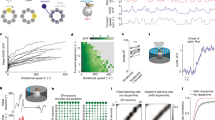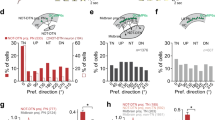Abstract
WE have formed a hypothesis which links two important, but so far separate, research areas, the monoaminergic system discovered by the Swedish group1,2 and the phenomenon of critical period plasticity in the visual cortex discovered by Wiesel and Hubel3,4. We propose5 that the widespread system of monoaminergic fibres plays a part in regulating plasticity and that, more specifically, catecholamines are responsible for maintaining the high level of plasticity which is observed in the visual cortex during the critical period4. In an initial test of this hypothesis, we developed a dose and timing regimen of 6-hydroxydopamine (6-OHDA) to produce significant depletion of catecholamines bilaterally in the visual cortex of developing kittens5. The hypothesis was confirmed to the extent that kittens treated with 6-OHDA do not have the usual cortical plasticity, as measured by a change in the ocular dominance of binocular neurones following monocular occlusion5. While all the results we have obtained so far with 6-OHDA are consistent with the view that catecholamines regulate cortical plasticity, other interpretations are possible because of the widespread nature of the changes accompanied by intraventricular 6-OHDA. We now present further evidence in support of the hypothesis from experiments involving microperfusion of catecholamine in localised areas of the visual cortex of animals which would not be expected to show plasticity. These experiments indicate a specific role of noradrenaline (NA) within the cortex because plastic changes are found only in the region of cortex perfused by NA while nearby cortical regions in the same kitten are unaffected.
This is a preview of subscription content, access via your institution
Access options
Subscribe to this journal
Receive 51 print issues and online access
$199.00 per year
only $3.90 per issue
Buy this article
- Purchase on SpringerLink
- Instant access to full article PDF
Prices may be subject to local taxes which are calculated during checkout
Similar content being viewed by others
References
Falck, B., Hillarp, N.-A., Thieme, G. & Torp, A. J. Histochem. Cytochem. 10, 348–354 (1962).
Fuxe, K. Acta physiol. scand. 64, Suppl. 247, 38–120 (1965).
Wiesel, T. N. & Hubel, D. H. J. Neurophysiol. 26, 1004–1017 (1963).
Hubel, D. H. & Wiesel, T. N. J. Physiol., Lond. 206, 419–436 (1970).
Kasamatsu, T. & Pettigrew, J. D. Science 194, 206–209 (1976).
Coyle, J. T. & Henry, D. J. Neurochem. 21, 61–67 (1973).
Pettigrew, J. D. J. Physiol., Lond. 237, 49–74 (1974).
Levick, W. R. Med. biol. Engl. 10, 510–515 (1972).
Hubel, D. H. & Wiesel, T. N. J. Physiol., Lond. 160, 106–154 (1962).
Author information
Authors and Affiliations
Rights and permissions
About this article
Cite this article
PETTIGREW, J., KASAMATSU, T. Local perfusion of noradrenaline maintains visual cortical plasticity. Nature 271, 761–763 (1978). https://doi.org/10.1038/271761a0
Received:
Accepted:
Published:
Issue date:
DOI: https://doi.org/10.1038/271761a0
This article is cited by
-
Noradrenergic signaling in the wakeful state inhibits microglial surveillance and synaptic plasticity in the mouse visual cortex
Nature Neuroscience (2019)
-
Inhibitory threshold for critical-period activation in primary visual cortex
Nature (2000)
-
Catecholamine-containing biodegradable microsphere implants as a novel approach in the treatment of CNS neurodegenerative disease
Molecular Neurobiology (1994)



